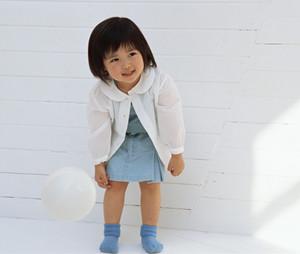Children with Cerebral Palsy: A Parent's Guide(作者 Elaine Geralis ) 选段6
 Children with Cerebral Palsy: A Parent's Guide(作者 Elaine Geralis ) 选段6
Children with Cerebral Palsy: A Parent's Guide(作者 Elaine Geralis ) 选段6
Chapter 1: What Is Cerebral Palsy? (3)
High Tone (Spasticity)
Children with increased tone are said to have high tone, hypertonia, or spasticity. If your child has high muscle tone, her movements will be stiff and awkward because her muscles are too "tight" and high muscle tone can be recognized by the way they arch their backs and stiffly extend their legs. Instead of rolling over in smooth, fluid movements, they move their trunks as one solid unit and flip over. Frequently, babies with increased tone roll over very early---for instance, at one month of age instead of the usual three to five months. they also love to stand on their stiff legs, but stand on their toes or scissor (cross) their legs tightly together when held upright.
Low Tone
Children with decreased tone are said to have low tone, hypotonia, or floppiness. If your child has low muscle tone, she has trouble maintaining positions without support because her muscles do not contract enough and are too relaxed. Babies with low tone like to lie on their backs (supine) with their head, trunk, arms, and legs limply resting on the floor or other face. It is difficult for children with low tone to remain upright against the pull of gravity in positions such as sitting and standing. As a result, a child with low tone usually sits leaning forward with a rounded back. Lowtone also affects a child's to keep her trunk stable enough so that she can use her arms to reach and grasp. And when low tone affects a child's abdominal and respiratory muscles, it can hinder the development of speech.
Fluctuating Tone
Children who have a combination of high and low tone are said to have fluctuating or variable muscle tone. If your child has fluctuating tone, her muscle tone may be low when she is at rest but then increase to high tone with active movement. Her tone increases to help stabilize a position such as sitting with a straight back, but may end up impossible to do movements such as reaching because too many muscle groups in the shoulders and arms tighten.

High Tone(scissoring legs)-肌张力过高(腿部交叉成剪)
Reference:The book “Children with Cerebral Palsy: A Parent's Guide”
译:
第一章:什么是脑瘫?(3)
张力过高(痉挛)
活动时肌肉张力增加过多的孩子被称拥有过高的张力,肌张力亢进,或是痉挛。如果你的孩子患有张力过高,那么他(她)的动作就会僵硬与笨拙,因为他(她)的肌肉太过“紧绷”且它们的张力没有达到平衡。张力过高的婴儿可以通过弯起的背部和僵硬的腿部来辨别出。不同于平顺,流畅的翻滚,他们会以一种坚硬的单元方式来移动和猛地翻转躯体。经常来说,张力过高的婴儿很早就会翻身---例如,在一个月大的时候,而不是通常的三到五个月。他们行动时也很喜欢依靠于僵硬的双腿,但是当挺直身子时又会以脚趾做着力点或者紧紧地剪起双腿(交叉)。
张力过低
活动时张力减少过多的孩子被称拥有过低的张力,肌张力减退,或是软弱无力。如果你的孩子张力过低,在没有支撑的情况下他(她)无法维持姿势,因为他(她)的肌肉收缩得不够且太过放松。张力过低的婴儿喜欢以背部着地躺着(仰卧),同时头部,躯干,胳膊,和双腿会软绵绵地摊在地面或其它表面上。张力过低的孩子很难在例如站立或坐着之类的姿态下保持挺直的身板。因此,他们通常坐着的时候会驼着背朝前倾靠。张力过低也影响了一个孩子维持躯干稳定的能力,所以他(她)很难运用手臂去抓够东西。同时,过低的肌张力影响了一个孩子腹部与控制呼吸的肌肉,因而它可能会阻碍语言的发展。
张力波动
拥有过高和过低的张力的综合的孩子被称拥有波动的或是可变的肌张力。如果你的孩子张力波动,他(她)的肌张力可能在静止不动的时候过低,而在积极活动的时候变成了过高。他(她)的肌张力为了稳定某种姿势,比如坐直后背,而增加,但是却可能最终使一些类似伸手的动作无法完成,因为太多太多肩膀和手臂的肌肉组绷紧了。

Low Tone (leaning forward with a rounded back)-肌张力过低(驼背前倾)
出处:书籍《Children with Cerebral Palsy: A Parent's Guide》.
High Tone (Spasticity)
Children with increased tone are said to have high tone, hypertonia, or spasticity. If your child has high muscle tone, her movements will be stiff and awkward because her muscles are too "tight" and high muscle tone can be recognized by the way they arch their backs and stiffly extend their legs. Instead of rolling over in smooth, fluid movements, they move their trunks as one solid unit and flip over. Frequently, babies with increased tone roll over very early---for instance, at one month of age instead of the usual three to five months. they also love to stand on their stiff legs, but stand on their toes or scissor (cross) their legs tightly together when held upright.
Low Tone
Children with decreased tone are said to have low tone, hypotonia, or floppiness. If your child has low muscle tone, she has trouble maintaining positions without support because her muscles do not contract enough and are too relaxed. Babies with low tone like to lie on their backs (supine) with their head, trunk, arms, and legs limply resting on the floor or other face. It is difficult for children with low tone to remain upright against the pull of gravity in positions such as sitting and standing. As a result, a child with low tone usually sits leaning forward with a rounded back. Lowtone also affects a child's to keep her trunk stable enough so that she can use her arms to reach and grasp. And when low tone affects a child's abdominal and respiratory muscles, it can hinder the development of speech.
Fluctuating Tone
Children who have a combination of high and low tone are said to have fluctuating or variable muscle tone. If your child has fluctuating tone, her muscle tone may be low when she is at rest but then increase to high tone with active movement. Her tone increases to help stabilize a position such as sitting with a straight back, but may end up impossible to do movements such as reaching because too many muscle groups in the shoulders and arms tighten.

High Tone(scissoring legs)-肌张力过高(腿部交叉成剪)
Reference:The book “Children with Cerebral Palsy: A Parent's Guide”
译:
第一章:什么是脑瘫?(3)
张力过高(痉挛)
活动时肌肉张力增加过多的孩子被称拥有过高的张力,肌张力亢进,或是痉挛。如果你的孩子患有张力过高,那么他(她)的动作就会僵硬与笨拙,因为他(她)的肌肉太过“紧绷”且它们的张力没有达到平衡。张力过高的婴儿可以通过弯起的背部和僵硬的腿部来辨别出。不同于平顺,流畅的翻滚,他们会以一种坚硬的单元方式来移动和猛地翻转躯体。经常来说,张力过高的婴儿很早就会翻身---例如,在一个月大的时候,而不是通常的三到五个月。他们行动时也很喜欢依靠于僵硬的双腿,但是当挺直身子时又会以脚趾做着力点或者紧紧地剪起双腿(交叉)。
张力过低
活动时张力减少过多的孩子被称拥有过低的张力,肌张力减退,或是软弱无力。如果你的孩子张力过低,在没有支撑的情况下他(她)无法维持姿势,因为他(她)的肌肉收缩得不够且太过放松。张力过低的婴儿喜欢以背部着地躺着(仰卧),同时头部,躯干,胳膊,和双腿会软绵绵地摊在地面或其它表面上。张力过低的孩子很难在例如站立或坐着之类的姿态下保持挺直的身板。因此,他们通常坐着的时候会驼着背朝前倾靠。张力过低也影响了一个孩子维持躯干稳定的能力,所以他(她)很难运用手臂去抓够东西。同时,过低的肌张力影响了一个孩子腹部与控制呼吸的肌肉,因而它可能会阻碍语言的发展。
张力波动
拥有过高和过低的张力的综合的孩子被称拥有波动的或是可变的肌张力。如果你的孩子张力波动,他(她)的肌张力可能在静止不动的时候过低,而在积极活动的时候变成了过高。他(她)的肌张力为了稳定某种姿势,比如坐直后背,而增加,但是却可能最终使一些类似伸手的动作无法完成,因为太多太多肩膀和手臂的肌肉组绷紧了。

Low Tone (leaning forward with a rounded back)-肌张力过低(驼背前倾)
出处:书籍《Children with Cerebral Palsy: A Parent's Guide》.
您在这个论坛的权限:
您不能在这个论坛回复主题